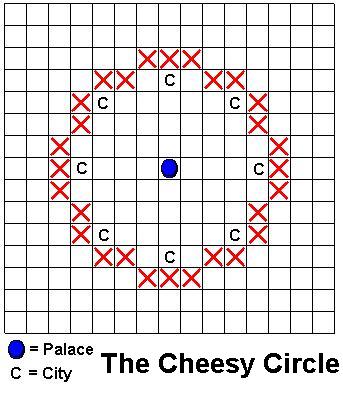City site selection (I currently play Emperor, random leaders, continents or fractal)
City spacing is set based on ideal location based on tile types, resources, and proximity to neighboring civilizations. Obviously, cities should be founded at locations that are best based on the map and long-term strategy.
I have found that I usually have a tendency to place my cities four spaces from my other cities. I don't choose a site that is specifically four spaces away, this is just usually how it works out. I usually have them on a different horizontal or vertical parallel. This results in fewer overlapping tiles.
I feel that spacing cities five tiles away often leaves many more unworked tiles. Spacing cities three tiles away limits workable tiles due to overlap and ultimately limits city size.
In general, when specific map factors do not dictate a specific city site, is it better to have your secondary cities (excluding you capitol, gp farm, and main production city, main commerce city) three tiles away to ensure you use all workable tiles?
I think this only matters late in the game, early in the game your secondary and third tier cities are often weenies that don't contribute much. This is also much less important if your are a war-monger. So assume this is a "peace-monger" strategy.
Please share any thoughts on city spacing.
City spacing is set based on ideal location based on tile types, resources, and proximity to neighboring civilizations. Obviously, cities should be founded at locations that are best based on the map and long-term strategy.
I have found that I usually have a tendency to place my cities four spaces from my other cities. I don't choose a site that is specifically four spaces away, this is just usually how it works out. I usually have them on a different horizontal or vertical parallel. This results in fewer overlapping tiles.
I feel that spacing cities five tiles away often leaves many more unworked tiles. Spacing cities three tiles away limits workable tiles due to overlap and ultimately limits city size.
In general, when specific map factors do not dictate a specific city site, is it better to have your secondary cities (excluding you capitol, gp farm, and main production city, main commerce city) three tiles away to ensure you use all workable tiles?
I think this only matters late in the game, early in the game your secondary and third tier cities are often weenies that don't contribute much. This is also much less important if your are a war-monger. So assume this is a "peace-monger" strategy.
Please share any thoughts on city spacing.



 or 100%
or 100%  etc. The Cheesy Circle was probably considered equally micromanagey, so they removed it by making distance costs not rounded anymore.
etc. The Cheesy Circle was probably considered equally micromanagey, so they removed it by making distance costs not rounded anymore.